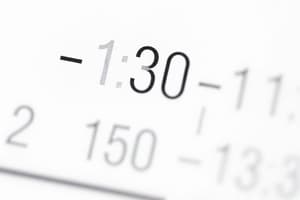Podcast
Questions and Answers
What is the general form of the mean formula?
What is the general form of the mean formula?
rac{ ext{sum of all data points}}{ ext{total number of data points}}
How do you calculate the mean of 2 and 3?
How do you calculate the mean of 2 and 3?
The mean of 2 and 3 is 2.5
What do mean calculations help us understand?
What do mean calculations help us understand?
Mean calculations help us understand trends and changes in patterns within datasets.
What is the purpose of calculating the mean of a dataset?
What is the purpose of calculating the mean of a dataset?
How does the mean formula relate to the sum of numbers and the total count?
How does the mean formula relate to the sum of numbers and the total count?
in the hearing test, subjects estimate the loudness (in decribels) of a sound , and the results are :68,67,70,71,68,75, 68, 62,80,73, 68 . what is the mean?
in the hearing test, subjects estimate the loudness (in decribels) of a sound , and the results are :68,67,70,71,68,75, 68, 62,80,73, 68 . what is the mean?
Flashcards are hidden until you start studying
Study Notes
Mean Calculation
In mathematics, we often need to calculate the average value of a set of data to get insights into its central tendency. This process involves finding the mean, which is calculated by adding up all the values and dividing them by how many there are. Let's break down this concept further using real examples from daily life.
Averages
An example of a mean calculation can be found when you look at test scores. For instance, say four students scored 86, 92, 74, and 83 points respectively. To find their average score, you would add these individual scores together (235) and divide that total by the number of tests taken (4), giving us an overall average of 58.75 points per student on each exam.
Sum of Numbers
The sum of numbers refers to the act of calculating the total amount of numerical quantities involved, such as the example mentioned above where we added the test scores. In other words, it's like counting up everything—adding one more thing doesn't change your understanding of what it means to count things.
Arithmetic Mean
Now let's dive deeper into the specific term 'arithmetic mean'. This type of mean measurement represents a quantity obtained by dividing the sum of certain specified quantities by the whole number of those quantities. It gives the measure of central tendency of the given data.
For example, consider the following scenario: If you have $10 worth of quarters and dimes combined, and you want to know how much money you actually own in terms of either coins alone; this would involve calculating both the total quarterly earnings plus the total dime earnings separately then dividing by 2.
Mean Formula
To represent mathematically the relationship between the sum of numbers and the average of those numbers, we use the general form of the mean formula:
[ \text{Mean} = \frac{\sum x_i}{n}],
where (x_i) represents any single element within our dataset, and (n) denotes the total number of elements considered. So if we were considering just two data points, this equation would work out to say (2 + 3)/2=2.5 since there are only 2 different datapoints being considered here, hence why they must be averaged over twice rather than once.
Mean Calculation
Finally, let's recap what we've covered so far about mean calculations: They involve determining the average value of a set of data through forming various relationships with all sorts of related measures like absolute deviation and standard error. Means take the first step towards comprehending the essential nature of things because they serve as indicators of trends and changes in patterns within large datasets.
Studying That Suits You
Use AI to generate personalized quizzes and flashcards to suit your learning preferences.




